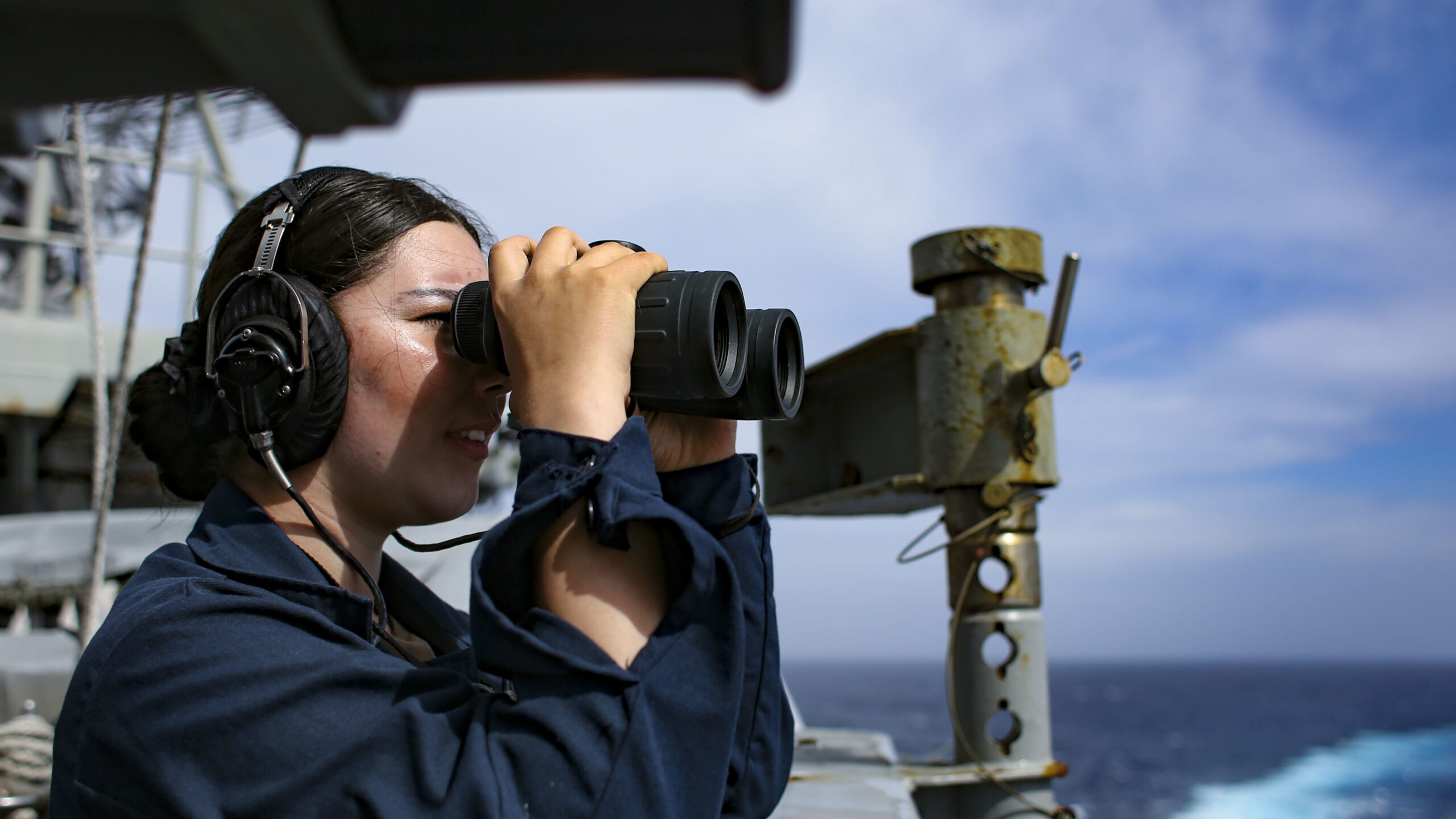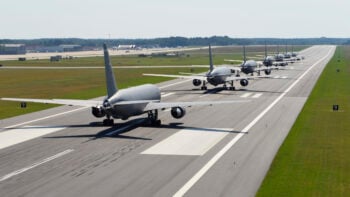
Boatswain’s Mate Seaman Recruit Cassandra Hortz, from Los Angeles, uses binoculars while on watch as the port aft lookout aboard the Nimitz-class aircraft carrier USS Abraham Lincoln (CVN 72), operating as part of U.S. Pacific Fleet. (U.S. Navy photo by Mass Communication Specialist Seaman Apprentice Julia Brockman)
SYDNEY — I’m a very deep person, caring deeply about fundamental things like life and death, freedom or its absence and the world’s ability to manage conflict of all kinds, in contrast to my colleague Valerie Insinna, who’s seriously into Taylor Swift. (I’m a Cat Stevens, Richie Havens kind of guy.)
So, taking Richie Havens’ “All Along The Watchtower” as my touchstone (“there must be some way outta here… the hour is getting late, late, late”) here is my list of the top five stories I wrote from my new vantage point atop the Indo-Pacific watchtower.
Looking from here changed my perspective. The vast wealth of the United States and its physical isolation fade quickly as mental balms once you cross the Pacific. Before reading, you may want to pour yourself a stiff brandy or a double tot of rum; it’s a tough region.
[This article is one of many in a series in which Breaking Defense reporters look back on the most significant (and entertaining) news stories of 2022 and look forward to what 2023 may hold.]
1. South Korean army training ‘very very bad‘
The least understood, most difficult to monitor nuclear power in the world, North Korea, faces South Korea, a US treaty ally. Should North Korea strike the south with either conventional or nuclear weapons, the United States is presumed to assist. That means the quality of the South Korean military really matters, and at the US Army’s LANPAC conference conference this year, a top former South Korean commander raised serious questions about Seoul’s troops.
2. US to boost Pacific spending but no real number yet
The Chinese government has grown increasingly belligerent and increasingly capable of projecting military force over the last few years. China has targeted the United States as its primary contestant. They are the world’s two biggest economies, and China has pumped huge amounts of money into its military, building aircraft carriers, warships, fighters and missiles at a rate of knots — though still significantly less than the US’s overall military budget. The United States possesses, arguably, the world’s best-trained and equipped military, capable of power projection at a scale no other country can match.
The US has identified the Peoples Republic of China as its “pacing threat” in both defense and national security policy. But money is strategy and, as this story makes clear, there are questions whether what former president Barack Obama originally called the Pacific Pivot has been taken seriously by Congress and the Pentagon, and received the funding it requires at the speed needed.
3. Aussies secretly cancel $1.3B drone deal
Australia, which has closely hitched its wagon to the United States and talks a great deal about long-range fires and power projection, made one inexplicable military choice this year — canceling purchase of General Atomics long-range armed drone, the Reaper. A deal seven years in the making, it went poof in a secret puff of smoke. The rationale offered, that the money was needed to beef up Australia’s cyber defense workforce at the the Australian Signals Directorate, seemed somewhat strained.
4. Is an epoch-making agreement between Australia and Japan in the works?
The answer to that headline is pretty simple: yes. Once one takes into account another story — I’ll leave it to my editors to decide if I’m sneaking six stories in instead of five [Editor’s Note: I’ll let is slide, this time.] — that the US and Australia will “invite Japan to integrate into our force posture initiatives” on the island continent. And Australia has clearly signaled it hopes Japan will take part in some AUKUS research and development. China has whined for years that it doesn’t want to see “Pacific NATO.” It may not face a single unified body of nations, but it already faces a network of allies that is drawing closer and closer together in ways once thought politically impossible.
5. Ukraine shows that city hopping is the new era of defensive warfare
Amid the stories of the horrors of Russia’s cowardly invasion of Ukraine are many lessons for modern war strategists. Two Australian generals shone a light on some of their thinking at the Army’s LANPAC conference (an underappreciated gathering). The idea that land warfare, with drones turning huge expanses into no-go areas, is now akin to Gen. MacArthur’s island-hopping campaign in World War II is pretty compelling. But a line by Lt. Gen. Richard Burr, the former head of Australia’s Army, should echo uncomfortably in all our minds: “Ukraine has shown that shaping and deterrence can fail, that assumptions can be wrong and that events can take on a life of their own. It shows the character of warfare may have changed, but its nature has not.”






















